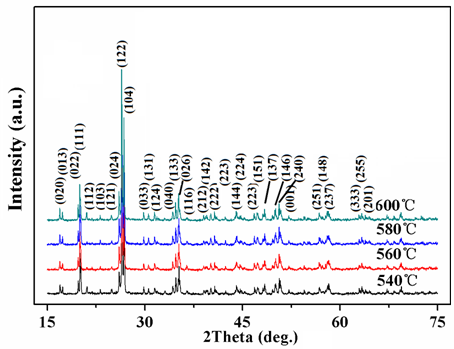Keywords: Ceramics, Cofiring, Microwave, Raman Scattering
The low temperature cofired ceramic (LTCC) technology has been used extensively for fabricating high performance microelectronic packages due to its durability, compactness, and manufacturability. The technology is especially useful for microwave application, which requires low temperature sinterable microwave dielectric ceramics with a wide range of dielectric constant (εr), a high quality factor (Qf), and an adjustable temperature coefficient of resonant frequency (τf).
However, at present, reducing the sintering temperature without affecting the electrical performance is still a big challenge, particularly for glass-free system. A new way is to use low melting temperature oxides as starting materials, such as molybdate and tellurate. Researchers from the Institute of Acoustics, Chinese Academy of Sciences report a new microwave dielectric material Li3(M3+)Mo3O12 (M=Fe) that have ultra-low sintering temperature (540°C~600°C).
The crystal structure, Raman scattering spectra, and dielectric properties of the material were investigated for the first time. The XRD patterns and the lattice structure of the new system were illustrated in Fig. 1. Single phase ceramics were obtained by the conventional solid-state route after sintering at a temperature of about only around 600°C. The atomic packing fraction, FWHM of the Ag oxygen-octahedron stretching Raman mode and Qf values of the samples sintered at different temperatures were found to correlate well with each other.
Also, the sample with a lower Raman shift showed a higher dielectric constant. Interestingly, the new system also exhibited a distinct adjustable temperature coefficient of resonant frequency (from -84 to 25×10-6/°C)) that can be controlled by sintering temperature. The new ultra-low fire glass-free ceramics is promising for microwave device applications.

Fig. 1 The XRD patterns of the Li3FeMo3O12 ceramics sintered at 540°C ~ 600°C (Image by WANG Yunli).

Fig. 2 Schematic illustration of the (4×4×4) supercell of the Li3FeMo3O12 material, where the blue part represents Li/FeO6 octahedron, and yellow part represents the MoO4 tetrahedron (Image by WANG Yunli).
This research was supported by the “100 Talents Program” of Chinese Academy of Sciences, the National Key Basic Research Program of China (973 Program, Grant no. 2013CB632900) and the open foundation of the State Key Laboratory of New Ceramics and Fine Processing of Tsinghua University.
References:
LIAO Qingwei, WANG Yunli, JIANG Feng, GUO Dong. Ultra-Low Fire Glass-Free Li3FeMo3O12Microwave Dielectric Ceramics. Journal of the American Ceramic Society (vol. 97, no. 8, pp. 2394–2396). DOI: 10.1111/jace.13073
Contact:
GUO Dong
Institute of Acoustics, Chinese Academy of Sciences, 100190 Beijing, China
Email: dong.guo@mail.ioa.ac.cn


